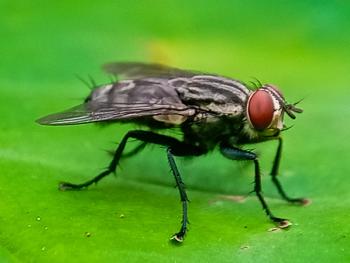
Just Ask the Expert: How do you detect Physaloptera species eggs?
Dr. Kevin Kazacos helps you pinpoint this parasite.
Dr. Kazakos welcomes parasitology questions from veterinarians and veterinary technicians.
We are seeing cases of Physaloptera species infection endoscopically but cannot demonstrate the ova in fecal parasite examinations. What technique would you suggest?
Thomas McCoy, DVM
Harvard Avenue Veterinary Clinic
Tulsa, Okla.
You've hit on a common difficulty in dealing with stomach worm (Physaloptera species) infections in dogs and cats. These parasites are most commonly associated with chronic intermittent vomiting,1-4 and for several important reasons you may not see eggs in fecal examinations even though the animal is showing clinical signs. The two most important reasons are
1. The worms are within the prepatent period, so they are too young to shed eggs.
Kevin R. Kazacos, DVM, PhD
2. Physaloptera species eggs are too heavy to be recovered by most routine flotation methods.1-4
In addition, female worms may not produce many eggs; often only a few (one or two) worms are present.1-4
Thus, many dogs and cats with endoscopically positive, clinical Physaloptera species infections will not have eggs in their feces,1-3 or, if they do, the eggs may be few and difficult to recover for a diagnosis. Even a single worm can cause gastritis and intermittent vomiting related to the irritation and inflammation caused by its anterior end being embedded in the stomach mucosa.1,3
FINDING THE RIGHT SOLUTION
Physaloptera species eggs are well-known as some of the heaviest we deal with, having a specific gravity estimated at 1.2376.5 This specific gravity is clearly above that of many flotation solutions routinely used by veterinary hospitals and commercial laboratories, resulting in false negative findings even in patent infections. This presents a diagnostic problem, as does the generally low and variable prevalence of the parasite (1% to 28% of dogs)4 and low infection levels as noted above.
Because of biological variation, a few eggs may float in solutions with slightly lower specific gravity, but flotation solutions needed to recover Physaloptera species eggs (and some others such as taeniid tapeworms) are generally above a specific gravity of 1.24.5-7 Sodium dichromate solution at a specific gravity of 1.36 has been recommended for detecting Physaloptera species eggs,6 and other higher specific gravity solutions would also work well.
My suggestion would be to use Sheather's sugar (sucrose) or sodium nitrate solution at a specific gravity > 1.24 (e.g. 1.25 to 1.27) for routine use in your practice. Or if you use solutions with a specific gravity of 1.20 to 1.22, I would recommend that you keep a bottle of one of the higher specific gravity solutions (sodium dichromate or nitrate solution) on hand for cases in which Physaloptera species infection is suspected.
The specific gravity of solutions is easily checked by using an inexpensive hydrometer.7 Keep in mind that slides using any high specific gravity salt must be examined immediately because of impending crystallization, which can be slowed by ringing the coverslip with clear fingernail polish.
ADDITIONAL TECHNIQUES
Another useful method for Physaloptera species egg recovery is sedimentation in water, which is easy to do and recovers heavy eggs. And if enough eggs are present, direct fecal smears (wet mounts) in saline solution may work, although they are generally considered much less efficient because of the small sample size. One case study found that direct smears recovered more Physaloptera species eggs than did fecal flotation, but this was directly related to the low specific gravity of the flotation solution used (sodium nitrate solution at a specific gravity of 1.200).2
In most cases in which no eggs are present in the feces,3 antemortem diagnosis will not be possible except by endoscopy (or gastrotomy). In such cases, it is important to do a thorough endoscopic examination on a distended stomach, since small, single worms hiding underneath rugal folds may be missed.3 In such cases, using a videoendoscope has been suggested for improving detection of the worms.3
Kevin R. Kazacos, DVM, PhD
Department of Comparative Pathobiology
School of Veterinary Medicine
Purdue University
West Lafayette, IN 47907
REFERENCES
1. Burrows CF. Infection with the stomach worm Physaloptera as a cause of chronic vomiting in the dog. J Am Anim Hosp Assoc 1983;19:947-950.
2. Clark JA. Physaloptera stomach worms associated with chronic vomition in a dog in Western Canada. Can Vet J 1990;31(12):840.
3. Theisen SK, LeGrange SN, Johnson SE, et al. Physaloptera infection in 18 dogs with intermittent vomiting. J Am Anim Hosp Assoc 1998;34(1):74-78.
4. Campbell KL, Graham JC. Physaloptera infection in dogs and cats. Compend Cont Educ Pract Vet 1999;21(4):299-314.
5. David ED, Lindquist WD. Determination of the specific gravity of certain helminth eggs using sucrose density gradient centrifugation. J Parasitol 1982;68(5):916-919.
6. Ehrenford FA. Diagnosis of Physaloptera in dogs by stool examination. J Parasitol 1954;40(Suppl):16.
7. Dryden MW, Payne PA, Ridley R, et al. Comparison of common fecal flotation techniques for the recovery of parasite eggs and oocysts. Vet Ther 2005;6(1):15-28.
Newsletter
From exam room tips to practice management insights, get trusted veterinary news delivered straight to your inbox—subscribe to dvm360.





